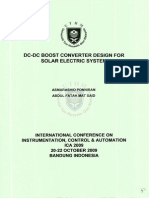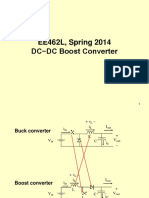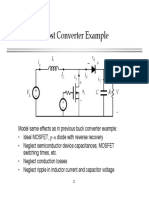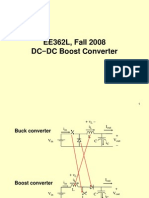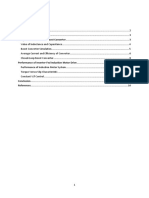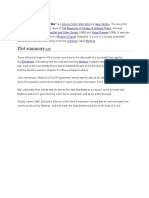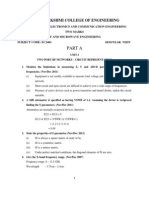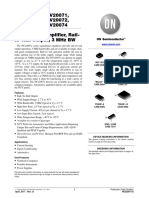Power Electronics Notes 07C Boost Converter Design Example
Marc T. Thompson, Ph.D. Thompson Consulting, Inc. 9 Jacob Gates Road Harvard, MA 01451 Phone: (978) 456-7722 Fax: (888) 538-3824 Email: marctt@thompsonrd.com Web: http://www.thompsonrd.com
Marc Thompson, 2008 M. T. Thompson, 2008
Boost Converter Design Example
�Summary
Design a boost converter with the following specifications: Input voltage: 12V Output: 24V @ 1A, 24 Watts Continuous conduction mode Inductor and capacitors: selected from following datasheets Switching frequency 100 kHz Output voltage ripple < 50 mV-pp Evaluate output ripple and estimate efficiency of converter
M. T. Thompson, 2008
Boost Converter Design Example
�Step-Up (Boost) DC-DC Converter
Output voltage is higher than the input, without a phase inversion
M. T. Thompson, 2008
Boost Converter Design Example
�Boost Converter Waveforms
Continuous current conduction mode
Switch closed:
di L VCC dt L
Switch open:
di L VCC v o dt L
Inductor Volt-second balance: VCC DT (VCC Vo )(1 D)T 0 L L V Vo CC 1 D
M. T. Thompson, 2008
Boost Converter Design Example
�Boost: Limits of Cont./Discont. Conduction
The output voltage is held constant For low load current, current conduction becomes discontinuous
M. T. Thompson, 2008
Boost Converter Design Example
�Boost Converter: Discont. Conduction
Occurs at light loads
M. T. Thompson, 2008
Boost Converter Design Example
�Boost Converter: Effect of Parasitics
The duty-ratio D is generally limited before the parasitic effects become significant
M. T. Thompson, 2008
Boost Converter Design Example
�Boost Converter Output Ripple
ESR is assumed to be zero Assume that all the ripple component of diode current flows through capacitor; DC component flows through resistor
M. T. Thompson, 2008
Boost Converter Design Example
�Boost Converter 1st-Cut Design --- Inductor
D = 0.5 What is minimum inductor value to keep this converter in continuous conduction mode ? (I.e. this converter operates at the continuous/discontinuous conduction boundary) Average diode current: 0.5Ipk(1-D) = Io = 1A Ipk = 4A Lmin =(Vo Vi)(1-D)T/i = (24-12)(0.5)(10-5)/4 = 15 H For the diode, ID,rms = I pk
1 = 2.3A 3
M. T. Thompson, 2008
Boost Converter Design Example
�Inductor Datasheet
Use 22 H (ESR = 0.085 Ohms) Note that series resonant frequency (SRF) is much higher than operating frequency Note that IRMS rating of this inductor is 2.7A
M. T. Thompson, 2008
Boost Converter Design Example
10
�Boost Converter Current Waveforms
M. T. Thompson, 2008
Boost Converter Design Example
11
�Boost Converter 1st-Cut Design --- Capacitor
What is minimum capacitor value ?
Vo pp
Vo D R f swC
C m in
Vo D ( 24 )( 0.5) 5 100 F f sw RVo pp 10 ( 24 )( 0.05 )
M. T. Thompson, 2008
Boost Converter Design Example
12
�Capacitor Datasheet
Use 3 47 F caps in parallel (35V, ESR = 0.9 Ohms)
M. T. Thompson, 2008
Boost Converter Design Example
13
�MOSFET Datasheet
This device is over-sized, but lets use it anyway
M. T. Thompson, 2008
Boost Converter Design Example
14
�1st Cut Design
M. T. Thompson, 2008
Boost Converter Design Example
15
�Simulation Result --- Inductor Current
Note that inductor ripple is about 3A peak to peak
M. T. Thompson, 2008
Boost Converter Design Example
16
�Simulation Result --- Output Ripple
Why is output voltage ripple so large ?
M. T. Thompson, 2008
Boost Converter Design Example
17
�Simulation Result --- Analysis
The culprit is capacitor ESR. Ripple current is 3A pp, divided into 3 capacitors. Ripple voltage = ripple current x ESR This is a problem with the boost converter --- large output ripple current makes sizing capacitor difficult
Ripple 1 V pp
M. T. Thompson, 2008
Boost Converter Design Example
18
�Mitigating Strategies
Parallel up more capacitors, or find capacitors with even lower ESR Alternative strategy: use lower ESR caps with a post-filter
M. T. Thompson, 2008
Boost Converter Design Example
19
�2nd Cut Design
Lower ESR capacitors and an LC post filter added
Lower ESR caps
M. T. Thompson, 2008
Boost Converter Design Example
20
�2nd Cut Design --- Simulation Results
Ripple 20 mV pp
M. T. Thompson, 2008
Boost Converter Design Example
21
�2nd Cut Design --- Efficiency Estimate
Losses due to: Inductor loss Switch conduction loss Switch switching loss Diode loss Capacitor ESR loss Gate drive loss
M. T. Thompson, 2008
Boost Converter Design Example
22
�2nd Cut Design --- Efficiency Estimate
Boost converter lecture example MTT 10-9-03 fsw 1.00E+05 L 2.20E-05 Vi 12 Vo 24 Rinductor 0.085 D 0.5 Rsw 0.0825 IL,avg 2 IL,max 3.36E+00 IL,min 6.36E-01 tsw 1.50E-07 IL,rms 2.15E+00 Isw,RMS 1.52E+00 Vd 0.8 Diode voltage Io 1 Output current Qg 1.00E-07 LOSSES CALCULATION Pdiode Pinductor Pswitch, conduction Pswitch, switching Gate drive loss Capacitor ESR loss
0.80 0.39 0.19 0.61 0.12 0.12
Total losses Output power Efficiency
2.23 24 91.5%
M. T. Thompson, 2008
Boost Converter Design Example
23
�2nd Cut Design --- Evaluation
FATAL DESIGN FLAW Note that ISAT rating of this inductor is 2.6A Peak current in inductor is 3.4A Therefore, this design will blow up
M. T. Thompson, 2008
Boost Converter Design Example
24
�3rd Cut Design --- Replace Inductor
Using next-size up Coilcraft inductor, Isat rating of 22 H inductor is 7.0A, RMS rating is 3.5A, so this should be OK Inductor loss will be lower due to lower DC resistance This comes at the cost of a more expensive inductor, and more PC board space needed
M. T. Thompson, 2008 25
Boost Converter Design Example









